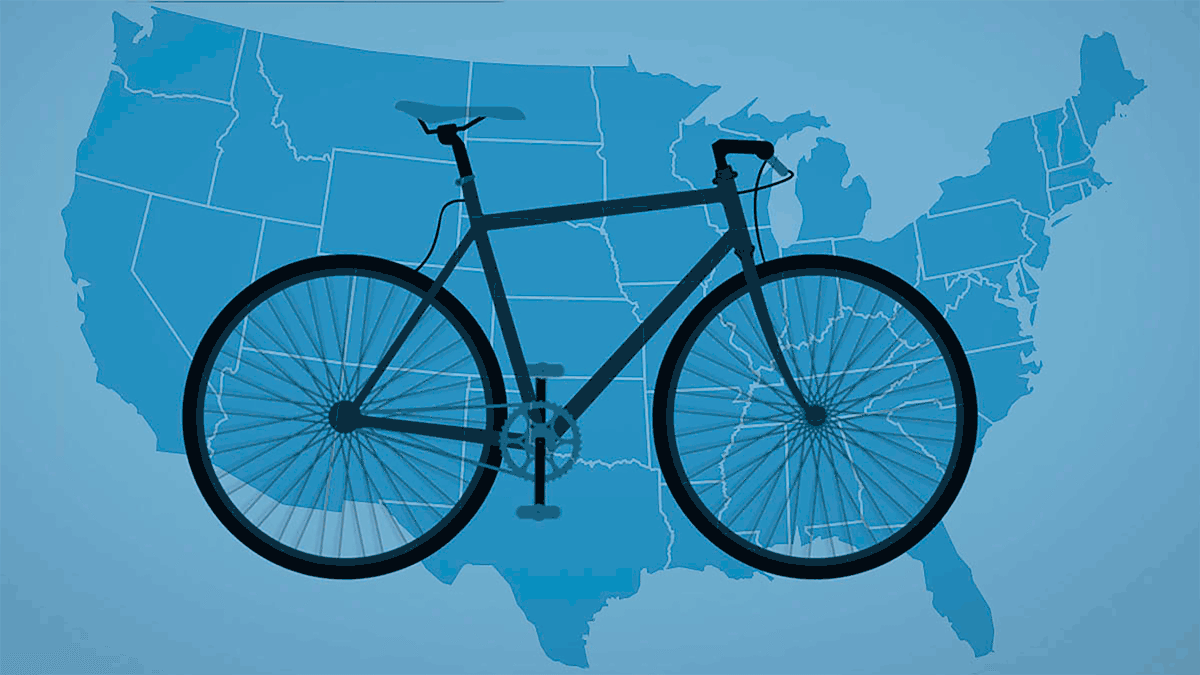Cruiser bikes—those retro-looking bikes, which usually only have one gear—are not uncommon on a paved bike trail. The woman I’m passing has a basket on hers, whose intrepid passenger is a small Yorkshire terrier. The wind parts his hair and he has an “I’m on an adventure” steely-eyed gaze.
Soon after, I hear a pileated woodpecker, apparently adding its pointillist flare to some dead wood in the nature preserve to my right; I stop to see if I can find it. A family on bikes pass me going the other direction. The little girl pedaling furiously to keep up with them offers me a wide, tooth-bare smile and a spirited wave.

Holmes County Trail City signs
Brandon WithrowI’m on the 63-mile Wabash-Cannonball Trail, my preferred ride from home in Northwest Ohio. It is a reclaimed abandoned railroad transformed into miles of paved and unpaved bike trail. This is travel within reach of many Americans, and once you experience trails like it, you’ll never look at your state the same way again. My spouse and I have even decided to turn our cycling into an ongoing project to see Ohio through the rail-trail system.
ADVERTISEMENT
We’ve discovered that to really get to know your state, that is, to get it to give up its secrets, you have to get out of the car—which can be a passive form of travel—and get on the bike.

"No Horses This Side of Trail" marker - Holmes County Trail shared with Amish buggies
Brandon WithrowThere are 2,082 rail-trails like the Wabash-Cannonball across the country (totaling 23,460 miles) that are built from former railways converted into paved and crushed stone paths. Thousands of more miles can be added simply by connecting other multi-use trails in an area. This is a project spearheaded by organizations like the Rails to Trails Conservancy (full disclosure: I’m a member). These rail-trails are meant to reconnect towns—a relationship lost by the rise of the interstate—offer healthy recreational opportunities, and provide affordable and clean avenues of transportation. They are intended to be enjoyed by almost any of the nonmotorized means one prefers.

Oak Openings Preserve connected to the Wabash Cannonball Trail
Brandon WithrowAnyone can ride these trails for as long or as little as they’d like. They can be taken alone or with family. From joggers, recumbent bikes, and adult tricycles, to a large dog pulling kids on skateboards, the means of nonmotorized travel on a trail is limited only by your imagination (and occasionally the local trail rules).
When we started cycling, we kept our trips close to home, but eventually discovered that for us to go the distance, owning the right equipment did wonders. We were fitted for the right-sized bikes by a local shop, exercising the Goldilocks principle of one bike being too large and another too small, but eventually finding one that was just right. We learned that the right pair of gel cycling shorts will help turn three miles into 30, and that we should never leave for a long trip without water, snacks, and spare tubes.
We felt equipped for our adventures, and were rewarded with unforgettable experiences.

“You can do this” written in chalk on The Wabash-Cannonball Trail
Brandon WithrowWe’ve cycled alongside horse-drawn buggies in Holmes County and met an Amish family jubilantly rollerblading. We discovered art installations near trees and tucked under overpasses in cities, as well as exuberant messages of “you can do this” chalked cheerfully on the pavement. We’ve been welcomed by hardy “moos” from cattle lining hills and a (rare) disconcerting sign warning of hunting near a trail. We’ve been greeted by boarded-up buildings lining main streets—artifacts that mark what once was—as well as signs of colorful revitalization.
If travel was a performance, the interstate would be seats in the audience, the local routes would be the stage, but the bike trails—those are backstage opportunities like these.
Some rail-trails we’ve cycled only once, but found that many are well-suited for return trips.

Kokosing Gap Trail (Former railroad)
Brandon WithrowOur local Wabash-Cannonball Trail, for example, is among many in Ohio, which has 95 finished rail-trails totaling 973 miles, and another 43 projects are underway. (For perspective, Ohio is only 225 miles wide.) The Wabash-Cannonball has North and South forks, which benefit from being connected to the flourishing Metroparks Toledo; it is connected to parks, forest preserves, a single track trail for mountain bikes, small towns, and historical sites.
In other words, it’s an adventure that one can return to regularly.
A single rail-trail can be shorter (just a mile or two) or longer (10 miles plus), and by using apps like Trail Link, we’ve found they can be connected for extending a ride. The Ohio and Erie Trail, for example, is several connected trails. A 320 mile trail project with 270 miles complete, it is designed for crossing the state from Cincinnati to Cleveland, even passing through the center of Cuyahoga Valley National Park.
Frequently, trailheads are located in towns, meaning that seeing a state by cycling rail-trails is more than logging the miles you put in during the day or connecting trails, it is also an opportunity to engage with towns and their hidden gems.

Art discovered along the Richland B&O Trail
Brandon WithrowOn a trip to Mount Vernon, Ohio to cycle the Kokosing Gap and Heart of Ohio trails, for example, we stayed at the family-owned Mount Vernon Inn, a memorable discovery with nice rooms tucked into a beautiful cottage garden, made to order breakfast, and complimentary wine at night. The Kokosing Gap and Heart of Ohio trails introduced us to the bubbling sounds of the Kokosing River, and allowed us to stumble onto the Hellbender Preserve, the home of Ohio’s largest amphibian, the Eastern Hellbender. They introduced us to the Brown Family Environmental Center, a 500-acre preserve packed with gardens and trails, the Schnormeier Gardens, a private garden inspired by a Japanese aesthetic and only open to the public four days a year, and the Ariel Foundation Park, a former glass factory repurposed into a 250-acre park.

Schnormeier Gardens Japanese Tea House, one mile from the Kokosing Trail.
Brandon WithrowFor us and other cyclists we’ve met along the way, rail-trails are passages to the mysteries of a state that are concealed from the window of a vehicle. From them emerge the passion of its people—a colorful landscape, both cultural and natural. They are chapters in the state’s unfolding story—flashes of some lost hopes and signs of new dreams.
And more importantly, they are reminders that if you want your world to be bigger, you may want to start with your own state.





